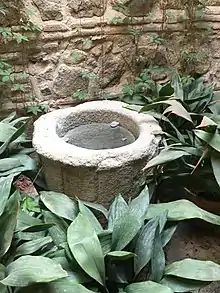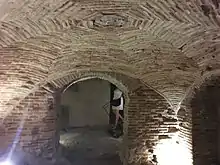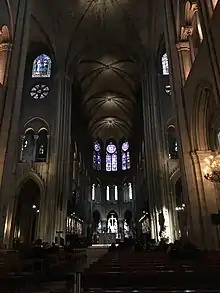Subterranean Toledo
Underneath the historic town of Toledo, Spain there is an underground city made up of wells, caves, Roman, Arabic, and Judaic baths, as well as centuries-old cemeteries. Previously little known, the underground structures have become a focus of tourist interest.
Tourism
In recent years, more and more people have been showing interest in this often-forgotten history, and now there are at least three separate professional tour groups (Cuéntame Toledo, Visitoledo, and Rutas de Toledo) giving tourists a closer look at Toledo’s rich underground history. Even restaurants will offer a peek into the Roman ruins underneath their building’s floor as Mercado de San Agustin[1] will do through the help of glass floors, or there are restaurants such as La Cave,[2] that serve meals in the cellars of their building by an ancient Roman cistern. In fact, the interest in Toledo’s subterranean history reached such a high point that a band named Subterráneo made a song named "Toledo" in 1987.[3]
Wells and Aljibes

There are wells all over Toledo – whether it is a still functioning water source tucked away in the corner of an outdoor patio in the center of an apartment complex or house, as is very common in the old part of the city, or whether it is the ruins of an ancient well that ran dry hundreds of years ago. Where there is a well, one may also find an aljibe, a now-Spanish word that originally came from the Arabic word for cistern. Perhaps one of the most-visited aljibes in Toledo is the one within the Alcázar of Toledo, but a close second may be the aljibe alongside the well of El Salvador.[4][5]
Caves
The best known cave in Toledo is the Cave of Hercules. There are several legends surrounding this cave, but by far the most recognized is the story of how Don Rodrigo in part caused the fall of Spain to the Moors by completing Hercules’ prophecy and opening the cave. Because caves are somewhat naturally occurring in Toledo, however, there are many more around the city, some which tourists can visit, others are not open to the public, or inaccessible to all. Some private residences within the old town also have historic caves that are sometimes available to the public, and many times in neighborhoods such as Las Covachuelas residents have caves underneath their homes.
Baths

Another large part of the Toledo underground is the Roman, Arabic, and Judaic baths. Included on the list of known historic baths in Toledo are: the Baños del Ángel, the baños de Tenerías, the Baños del Caballel, and the Baños del Cenizal which are all Arabic baths one can visit. There is also the beautifully reconstructed Roman baths of the Plaza de Amador de los Ríos,[6] and finally underneath a house in the Jewish Quarter there is thought to be a mikveh, for purification baths – for which naturally running water was needed.[7]
Cemeteries
Perhaps even more common than wells and caves in Toledo are its cemeteries, so much so that a common phrase to hear is that "In Toledo, there are more dead people than alive".[8] To begin, there was the "cementerio general de la Vega Baja” that was built in part to accommodate for the massive increase in the death toll from cholera. The cemetery took in new graves from 1836 to 1893, at which time families actually had to move deceased loved ones’ graves to the cemetery of Our Lady of the Sagrario, when the city announced they would be demolishing the deteriorating cemetery. There are also several smaller church and hospital-specific cemeteries around the city.[9] Outside of the old Hospital de la Misericordia there is a cemetery that began as a burial place for all who died at the hospital, but when cholera hit Toledo, it quickly became a cemetery strictly for the nuns who lived and died there.[10] A more famous hospital, the Hospital de Tavera, contains the crypt and impressive marble sculpture of the Cardenal Tavera, who built the hospital. This sculpture has been seen and written about by many, including Luis Buñuel in his film Tristana and Becquer has described and drawn the famous grave.[11] Another crypt exists in the Iglesia de San Roman, and within lies skeletons and even some well-remained mummies, and another mummy, that of King Sancho IV was found in 1947 in the Cathedral of Toledo.[12] In 2008, a previously undiscovered Jewish cemetery was found during a routine archeological excavation that always takes place before new construction begins.[13]
Cathedral

In the article, "Toledo Cathedral MS Reservado 23: A Lost Manuscript Rediscovered", author and musicologist Robert J. Snow describes his discovery of a manuscript, previously thought to be lost, in an underground vault beneath the cathedral of Toledo. Snow describes the vaults as "a group of three or four subterranean rooms to which one descends through a small door located immediately to the right of the door leading from the church into the hall where the Cathedral".[14] Although the presence of the underground rooms was previously known, the discovery of new music manuscripts in the subterranean rooms of the Cathedral suggests that further discoveries remain to be made beneath the city.
See also
References
- "Restaurant Mercado San Agustin". Retrieved 21 June 2017.
- "Restaurant La Cave". Retrieved 21 June 2017.
- Esquitino, David. "SUBTERRÁNEO banda toledana de heavy rock de los 90". Música Quintanar. Retrieved 22 June 2017.
- Oliva, Alberto Lopez. "13 Rutas subterráneas de Toledo". Pasearte Toledo. Retrieved 17 June 2017.
- Oliva, Juan Luis Alonso. "14 Cuevas o subterráneos impresionantes en Toledo". Leyendas de Toledo. Retrieved 17 June 2017.
- "Los baños y cuevas de Toledo". Sapos y Princesas. Retrieved 18 June 2017.
- Arias, Jose María Gutiérrez. "El micvé del Callejón del Verde". Ayudas a la rehabilitación: Consorcio de Toledo. Retrieved 19 June 2017.
- Gray, Geoffrey (21 December 2012). "In Toledo, Layers of Spanish History". The New York Times. Retrieved 25 June 2017.
- "El Cementerio Municipal de la Vega Baja". Ayuntamiento de Toledo.
- Cerdeño, Jesús J. "El Cementerio de La Misericordia, Toledo". Tres Culturas. Retrieved 12 June 2017.
- Cerdeño, Jesús J. "El Hospital de Tavera". Misterios de Toledo. Retrieved 20 June 2017.
- Oliva, Juan Luis Alonso. "Momias en Toledo". Leyendas de Toledo. Retrieved 22 June 2017.
- "La Judería de Toledo: El Cementerio". Todo Calidad. Retrieved 19 June 2017.
- Snow, Robert J. (1983). "Toledo Cathedral MS Reservado 23: A Lost Manuscript Rediscovered". The Journal of Musicology. 2 (3): 246–277. doi:10.2307/763730.

